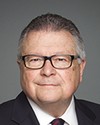Mr. Speaker, the committee heard from an extensive list of witnesses representing a range of experiences, backgrounds and expertise, people who could offer good, practical input into the operation of our correctional system. They had some very clear recommendations to make. The committee listened to them and then acted on the recommendations.
As I mentioned in my remarks, the proposed amendments came from all parts of the table, not just one side or the other. All the political parties involved made recommendations to respond to the witnesses. There were amendments from all sides that were ultimately accepted by the committee. It was truly a collaborative effort to make sure that the legislation would achieve the objectives we set for it, which was to abolish the old practice of administrative segregation and replace it with a whole new approach whereby we would retain the ability to separate inmates for physical and safety reasons while at the same time having the capacity to continue with programming, mental health services, human contact and so forth that would ultimately lead toward rehabilitation.
The committee listened to that evidence very carefully and then crafted amendments that would deliver on the objectives of the legislation, particularly the element of external oversight and review, which is a critical element in assuring the public and all stakeholders interested in the correctional system that, in fact, the administration of the system was being conducted properly. The independent review process externally was the committee's greatest contribution.

